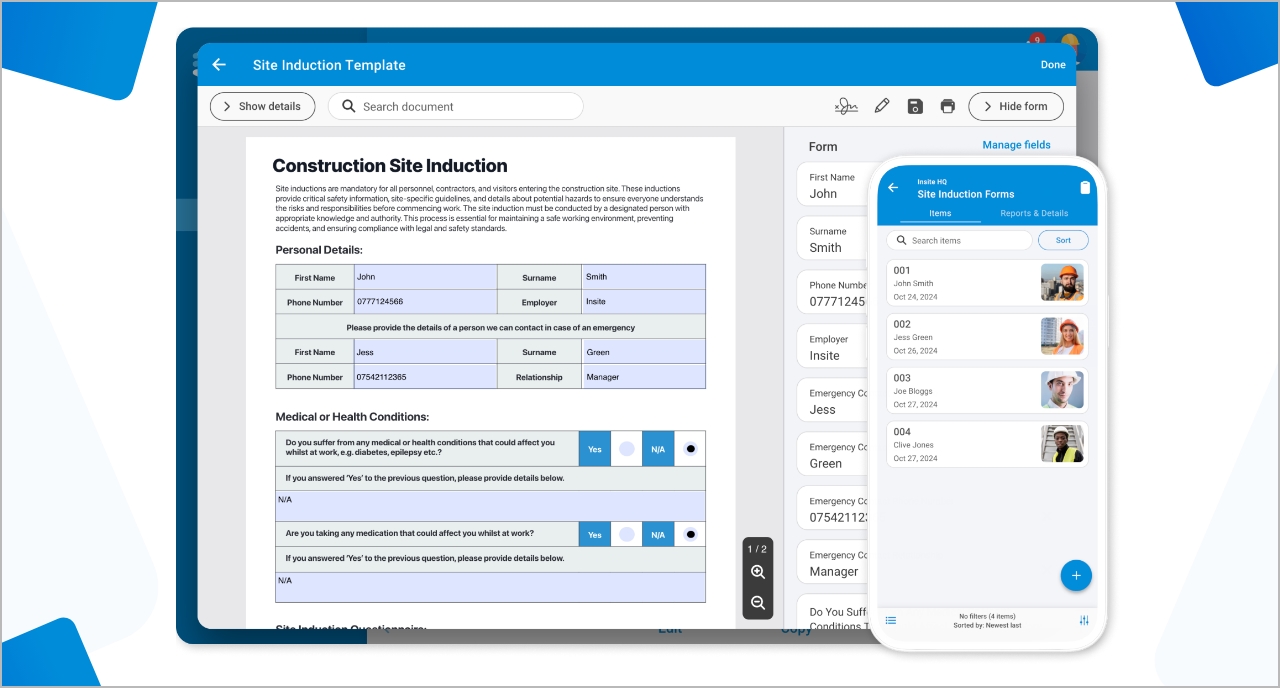Resources
Case studies
Videos
Sample reports
Free inspection templates
Learn
Blog
Product brochure
Training pack
Get the app
Download the app
Changelog
2024-11-11 | 6 min read
tags: Inspection Free-Template Insite
Ensuring Safe Lifting Practices Through a Comprehensive LOLER Checklist

Introduction
In industries where lifting equipment is essential, safety protocols for lifting operations are critical to prevent accidents and maintain regulatory compliance. Incidents related to lifting equipment can result in severe injuries, costly repairs, and legal repercussions, making it essential to establish clear safety procedures. A LOLER (Lifting Operations and Lifting Equipment Regulations) inspection checklist template ensures that all equipment and procedures meet the necessary standards before any lifting task begins. This blog explores the importance of LOLER inspection checklists, breaks down their key components, and demonstrates how using the right template can enhance safety in lifting operations.

Understanding LOLER inspection checklists
What is a LOLER inspection checklist?
A LOLER inspection checklist is a structured document that guides safety officers and operators through essential safety checks for lifting equipment. The checklist covers everything from equipment condition and load limits to operator training and site conditions, ensuring compliance with the UK’s LOLER regulations. By following the checklist, organisations can systematically address potential hazards, reduce risks, and protect workers from harm.
Types of lifting operations requiring LOLER compliance
LOLER regulations apply to a wide range of lifting operations and equipment types. These operations include, but are not limited to:
Cranes and hoists: Heavy lifting equipment used on construction sites or in industrial environments.
Forklifts and telehandlers: Vehicles designed for moving heavy loads across sites.
Chains, slings, and shackles: Essential components used in securing loads during lifting operations.
Aerial lifts and boom lifts: Equipment allowing workers to perform tasks at height while lifting loads.
Each of these types of equipment requires regular inspections to maintain safety standards and prevent accidents.
The importance of LOLER compliance
Potential hazards of lifting operations
Lifting operations involve significant risks, including the potential for equipment failure, load instability, and operator errors. Common hazards include:
Equipment overloading: Using equipment beyond its load capacity can lead to failure and accidents.
Component wear and tear: Damaged chains, hooks, or other components increase the risk of sudden equipment failure.
Environmental conditions: Poor weather, unstable surfaces, and restricted visibility can compromise lifting safety.
Understanding these hazards is key to implementing effective LOLER-compliant procedures.
Legal requirements and compliance
In the UK, the LOLER regulations mandate specific safety protocols for lifting operations, requiring regular inspections, proper maintenance, and operator training. Compliance is a legal necessity that helps prevent accidents, reduce liability, and avoid potential fines or penalties. Implementing a LOLER inspection checklist not only ensures regulatory compliance but also demonstrates a commitment to worker safety and operational excellence.
Real-life incident highlighting LOLER importance
In 2020, a UK manufacturing plant experienced a serious incident when a crane, overloaded beyond its capacity, failed and dropped its load, causing injuries to two workers. An investigation revealed the absence of a thorough LOLER inspection, emphasising the critical role of checklists in lifting safety. This incident underscores the importance of a structured LOLER inspection process to avoid such risks.

Essential components of a LOLER inspection checklist template
An effective LOLER inspection checklist template covers a wide range of safety checks and procedures. Here are the key elements:
1. Equipment condition and suitability
The checklist begins with verifying that all lifting equipment is in suitable condition for the specific task. Inspections should cover:
Load capacity ratings: Ensure each piece of equipment is rated for the intended load and prominently marked with capacity indicators.
Component integrity: Inspect chains, hooks, and cables for wear, corrosion, or other signs of damage.
2. Installation and setup protocols
Correct setup is essential for safe lifting operations. The checklist should confirm that equipment is positioned on stable ground and that setup procedures follow the manufacturer’s instructions.
Ground stability: Confirm that surfaces are stable, level, and capable of supporting the weight.
Setup checks: Verify that equipment is properly assembled, with all safety mechanisms in place.
3. Regular maintenance and record-keeping
Routine maintenance is crucial for preventing equipment failure. The checklist should include a section for reviewing the equipment’s maintenance history and logging inspection details.
Maintenance schedule: Ensure all maintenance tasks are up-to-date.
Inspection logs: Record each inspection with the date, inspector’s name, and any identified issues or repairs.
4. Operator competency and training
LOLER compliance requires that only trained and competent individuals operate lifting equipment. The checklist should verify operator certifications and training.
Training verification: Confirm that all operators have relevant certifications.
Briefing on safety protocols: Ensure all involved personnel are briefed on the lifting plan and safety measures.
5. Load assessment
Overloading is a common risk in lifting operations. The checklist should prompt a detailed assessment of the load’s weight, stability, and distribution.
Load weight check: Ensure the load weight is within equipment capacity.
Secure load handling: Verify that loads are securely attached and balanced to prevent shifting.

How to use a LOLER inspection checklist template
Using a LOLER inspection checklist template effectively requires careful adherence to each section and a commitment to thoroughness. Here’s a guide:
Step 1: Perform a site and equipment assessment
Inspect the environment and equipment setup to ensure conditions are stable and hazard-free. Review the checklist to confirm that all preliminary steps have been completed.
Step 2: Complete the equipment and load checks
Go through each checklist item, covering equipment condition, load capacity, and secure attachments. Address any identified issues before proceeding with lifting operations.
Step 3: Confirm operator training and readiness
Verify that all operators have the necessary certifications and are familiar with the checklist requirements. Hold a safety briefing to discuss the operation and identify any additional precautions.
Step 4: Document and approve the checklist
Record the completed checklist and obtain approval from a supervisor or safety officer. This final step ensures accountability and prepares your documentation for audits.

The advantages of a digital LOLER inspection checklist
While paper-based checklists are effective, digital checklists offer several benefits that improve efficiency, accessibility, and record-keeping. Here’s how digital solutions, like those from Insite, enhance LOLER compliance:
Real-time access and communication
With digital checklists, supervisors can review and approve inspections instantly, facilitating seamless communication and reducing delays.
Enhanced record-keeping
Digital templates automatically store and timestamp inspection records, creating a comprehensive, easily retrievable digital log for audits.
Universal accessibility
Digital checklists can be accessed from any device, allowing remote team members or supervisors to review checklists in real time.
Choosing the right LOLER inspection checklist template
When selecting a LOLER inspection checklist template, consider the following factors to ensure it meets your needs
Customisation for specific tasks
Choose a template that allows customisation for various types of lifting tasks, ensuring that each operation’s unique risks are addressed.
Ease of use and clarity
A user-friendly checklist template reduces the likelihood of mistakes, promoting consistent safety compliance across teams.
Digital integration
Consider a digital checklist solution that integrates with your existing systems for streamlined access, real-time updates, and improved record-keeping.

Conclusion
Incorporating a comprehensive LOLER inspection checklist into your lifting operations is essential for safety, compliance, and efficiency. A well-structured template not only simplifies the inspection process but also promotes a culture of safety, reducing risks and protecting both workers and assets.
Ready to elevate your lifting safety protocols? Download our free LOLER inspection checklist template and take the first step towards safer, compliant lifting operations on your site.
Get started with Insite
If you’re looking for a solution, Insite is here for you. Book a demo or sign up for a trial today. Get in contact for further information we’re here to help and will be happy to answer any questions you may have.